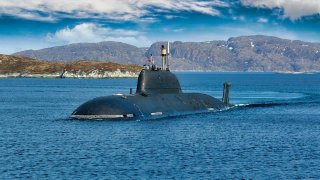A Russian Nuclear Attack Submarine Caught Fire and No One Knows Why
On November 8, 2008, the K-152 Nerpa, a Russian Akula-class nuclear-powered attack submarine, experienced a tragic disaster during sea trials in the Sea of Japan.
What you Need to Know: On November 8, 2008, the Russian nuclear-powered attack submarine K-152 Nerpa experienced one of the deadliest peacetime submarine disasters during sea trials in the Sea of Japan.

-The Akula-class submarine's fire suppression system mistakenly activated, flooding two forward compartments with halon gas, killing 20 people, including 17 civilians, and injuring 41 others.
-The accident's cause remains unclear, with initial investigations blaming a sailor for allegedly tampering with the system. However, he was later acquitted in two trials, and the true reason behind the malfunction remains unknown, casting a shadow over the incident to this day.
The Nerpa Tragedy: Russia’s Deadly Submarine Disaster Explained
On Nov. 8, 2008, the K-152 Nerpa, a Russian nuclear-powered attack submarine, cruised the depths of the Sea of Japan on sea trials to determine her readiness state. Construction was completed that year, and the submarine was running tests with a large complement of civilian contractors and engineers aboard to monitor the reactor's state.
Tragically, many would lose their lives in one of the worst submarine disasters in Russian history.
Introducing the Nerpa
K-152 is an Akula-class boat, measuring in at over 350 feet long. The Akula class was one of the last submarines developed by the Soviet Union before its dissolution. Its first deployment in 1986 was an important event — Western analysts thought the Soviets were at least 10 years away from producing anything like the Akula. These attack boats feature a double hull design. In the inner hull is the pressure vessel, which keeps out the crushing pressure of water at depth. The outer hull is not structural. This so-called light hull gives designers much more flexibility in shape and storage.
While not much information is known about specific submarines and their operating capabilities due to the secretive nature of naval services, it is estimated that these boats can reach depths of 2,000 feet and travel at speeds in excess of 40 knots underwater. Being attack submarines, the boats come heavily armed, with eight torpedo tubes capable of carrying both torpedoes and missiles. A unique bulge on top of the rudder fin houses a highly sensitive towed sonar array to assist in locating enemy ships and submarines.
The Incident
Fire on any ship is devastating, and submarines are no exception. Firefighting techniques have evolved, and most military ships now use a type of gas known as halon to swiftly smother fires. This gas displaces oxygen, starving fire of a critical component while also helping prevent the chemical reaction of burning.
At 8:30 p.m. on Nov. 8, the two forward compartments of the Nerpa were sealed and flooded with firefighting gas. Tragically, 20 individuals perished, 17 of them civilians, and a further 41 were injured.

The cause of the disaster was not immediately clear. The Nerpa was fitted with a new firefighting system that could automatically release the gas should it detect an increase in temperature or smoke.
Some believed this system had malfunctioned and released the gas by mistake. An investigation by the Russian Navy sought to lay the blame on a sailor who, it was claimed, became bored and activated a fire suppression terminal.
He then allegedly increased the temperature reading far above the safe limit and granted permission to the system to release its halon. But the sailor in question was highly knowledgeable and professional.
He was later acquitted in two trials, and the cause of the accident remains a mystery today.
About the Author: Maya Carlin
Maya Carlin, a Senior Editor, is an analyst with the Center for Security Policy and a former Anna Sobol Levy Fellow at IDC Herzliya in Israel. She has by-lines in many publications, including The National Interest, Jerusalem Post, and Times of Israel. You can follow her on Twitter: @MayaCarlin.
Image Credit: Creative Commons.


